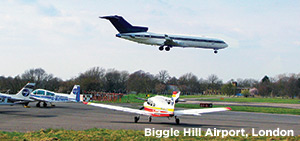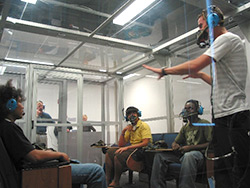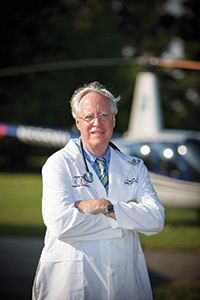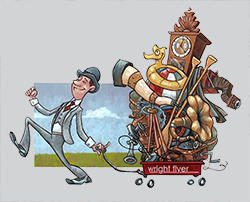Pilot Briefing
American pilots are getting a bargain
 It is satisfying for American pilots to look across the Atlantic Ocean at the cost of flying in England. Consider the experience of Martyn Draper, who was born in England but got his certificate in the United States where he now lives and flies.
It is satisfying for American pilots to look across the Atlantic Ocean at the cost of flying in England. Consider the experience of Martyn Draper, who was born in England but got his certificate in the United States where he now lives and flies.
Draper returned to the United Kingdom a few years ago for a vacation and got a shock. It cost him $13 to land at Headcorn Aerodrome, a grass field with no facilities. When he returned to Lydd Airport 18 miles away, he got a bill for $260 for the Cessna 172 and instructor he’d hired for eight-tenths of an hour.
There are landing fees, touch-and-go fees, and fees to practice an instrument approach. Draper discovered it would have cost him more than $700 to do six instrument approaches for 2.5 hours with an instructor in a Cessna 172.
Then there are the rules. To taxi the aircraft from its parking spot to a fuel pump, Draper was required to radio the flight school’s front desk for permission. He couldn’t walk out of the FBO to fly an airplane without wearing a safety vest, although it wasn’t needed for preflight. When flying overhead or near a nontowered airport, he had to report how many souls were on board as part of his position transmission.
Draper’s experience came six years ago. In December 2010 at the Biggin Hill School of Flying near London, a Cessna 172 without a glass cockpit rents for $164 an hour, but there is a VAT (value added tax) of $36, a full-stop landing fee of $36.84, and a “per-circuit” fee (touch-and-go) of $12.21. In addition, the fuel surcharge for nonstudents is $19.59 per hour (fuel is $9.75 per gallon). The total hourly cost including one touch and go is $268.64.
An ILS approach at Biggin carries a fee of $78, so to make an approach and actually land the cost is $114.84. Biggin Hill School of Flying instructors take their students to a less expensive airport and practice ILS approaches for $25.75 per approach. To British pilots, America is still a bargain.
Deal struck to sell Continental, Mattituck
Agreement has been reached by parent company Teledyne Technologies on a proposed sale of Continental Motors and Mattituck Services to Technify Motor, a unit of the AVIC International Holding Company of China. AVIC had $6 billion in sales in 2009 and has substantial business operations in aviation.
The company is to be sold for $186 million in cash. The 80-year-old company is to retain its service centers in Fairhope, Alabama, and Mattituck, New York. The sale is expected to close in the first quarter of 2011. It must be approved by the Chinese government, and must receive clearance in the United States under the Hart-Scott-Rodino Antitrust Improvements Act. It must also be approved by the U.S. Committee on Foreign Investment in the United States.
If the sale is completed, Continental Motors will remain in Mobile, Alabama, and retain current senior management. The proposed owner has pledged to continue investing in technology development, including diesel engines.
AVIC is a partner and supplier to Boeing, Airbus, Honeywell, and engine manufacturer Snecma. The purchase promises entry into the potential China market. There are 230,000 general aviation aircraft in the United States; China has as yet only 900 small aircraft. That market is expected to grow over the next decade.
Continental produced its first commercial engine in 1929. There are several foreign companies operating factories in Mobile, including Germany (ThyssenKrupp’s steel mill and Evonik Degussa’s chemical plant), Australia (Austal USA shipbuilding) and Singapore (ST Aerospace Mobile). The European Aeronautic Defence and Space Company has Airbus engineering centers in the Mobile area.
Embry-Riddle offers hypoxia training
 Embry Riddle Aeronautical University in Daytona Beach, Florida, has opened a normobaric “altitude chamber” that’s open to the public. The High Altitude Lab doesn’t reduce air pressure like a hypobaric version does. Instead, it simply removes oxygen from the air to simulate the lack of oxygen at altitude. Participants will feel the effects of hypoxia and see its effects on others. Since the lab does not reduce pressure, participants do not experience trapped gases or decompression sickness (“the bends”) as with traditional altitude chambers. Of course, the downside to this method is the inability to simulate a rapid decompression that could occur in pressurized airplanes. This course offers an excellent opportunity to experience hypoxia symptoms in a safe, controlled environment employing airline-style oxygen masks for recovery. However, it does not satisfy the FAR 61.31(g) high-altitude signoff, which requires tasks in a flight simulator or flight-training device.
Embry Riddle Aeronautical University in Daytona Beach, Florida, has opened a normobaric “altitude chamber” that’s open to the public. The High Altitude Lab doesn’t reduce air pressure like a hypobaric version does. Instead, it simply removes oxygen from the air to simulate the lack of oxygen at altitude. Participants will feel the effects of hypoxia and see its effects on others. Since the lab does not reduce pressure, participants do not experience trapped gases or decompression sickness (“the bends”) as with traditional altitude chambers. Of course, the downside to this method is the inability to simulate a rapid decompression that could occur in pressurized airplanes. This course offers an excellent opportunity to experience hypoxia symptoms in a safe, controlled environment employing airline-style oxygen masks for recovery. However, it does not satisfy the FAR 61.31(g) high-altitude signoff, which requires tasks in a flight simulator or flight-training device.
While air machines extract oxygen from the lab enclosure, students are given cognitive, motor, and flight-related tasks to perform while noting the onset of hypoxic symptoms. There is also a Frasca flight simulator in the lab that replicates a Cessna 172 with a Garmin G1000 cockpit. Besides the lab portion, the four-hour course provides instruction in flight physiology similar to the military programs. ERAU says it is coordinating with the local flight standards district office to allow pilots to receive credit toward the FAA’s Wings program.
Cost of the program is $375 per student, and the lab can seat up to eight. Candidates must be 18 years or older and hold an FAA medical certificate. Contact Assistant Professor Glenn Harmon or call 386-226-6843. —Pete Bedell
Tangier Island doctor’s legacy lives on
 Dr. David B. Nichols discovered his mission early in life. As a young medical student in Canada, Nichols visited his parents who had moved to Virginia and toured Tangier Island, located 10 miles off the state’s coastline in the Chesapeake Bay. While there, Nichols learned that the remote island had no reliable medical care. From that moment, he decided to earn a medical degree so that he could provide care to people who lived on the island. He completed his residency in Virginia and earned his pilot certificate so that he could fly to the island to provide care. For more than three decades, he faithfully flew a Cessna Skylane or Robinson R44 to the island nearly every Thursday.
Dr. David B. Nichols discovered his mission early in life. As a young medical student in Canada, Nichols visited his parents who had moved to Virginia and toured Tangier Island, located 10 miles off the state’s coastline in the Chesapeake Bay. While there, Nichols learned that the remote island had no reliable medical care. From that moment, he decided to earn a medical degree so that he could provide care to people who lived on the island. He completed his residency in Virginia and earned his pilot certificate so that he could fly to the island to provide care. For more than three decades, he faithfully flew a Cessna Skylane or Robinson R44 to the island nearly every Thursday.
AOPA turned to him for assistance in its General Aviation Serves America campaign, and he helped film a commercial about the important role small airports play in helping him provide medical care on the island. He was the focus of an article and accompanying video in the September 2009 issue of AOPA Pilot.
Nichols, 62, died in his Virginia home December 30 after a battle with cancer.
Last June, Nichols was featured on National Public Radio. Soon after the feature aired, the unexpected news of his terminal illness was announced. Then, the well-deserved recognition came pouring in. He was highlighted on NBC Nightly News “Making a Difference” and recognized by local, state, and national dignitaries and aviation associations during the clinic’s opening ceremony. He also was honored with the first “Country Doctor of the Decade” award.
AOPA presented Nichols with a Presidential Citation for the use of general aviation in his humanitarian efforts.
Nichols had a plan for a state-of-the-art medical clinic to be built on the island—the rundown 50-year-old clinic he had been practicing in for 30 years just wouldn’t do any longer, he decided. For five years, Nichols, his friend Jimmie Carter, and the Tangier Island Health Foundation worked to raise $1.7 million to build a clinic. The David B. Nichols Health Center opened in August, just a few months after Nichols was diagnosed with the terminal disease.
“Dr. Nichols’ generosity, selflessness, and dedication to the people of Tangier Island were nothing short of extraordinary,” said AOPA President Craig Fuller. “He used his skills as both a physician and a pilot to their highest purpose, and his life will continue to be an inspiration to all of us in the aviation community.”
Nichols, who knew his time with the island residents was running short, reassured the Tangier community of his love and dedication during a bittersweet speech August 29 at the clinic’s grand opening.
“While I will leave you in body, I will never leave you in spirit,” he said in his closing remarks. “I will keep an eye on you.” —Alyssa J. Miller
Hawker 400 upgrade development begins
Hawker Beechcraft Services (HBC) has acquired the first test aircraft and initiated design engineering on its $2.24 million high-performance upgrade for Hawker 400XP and Beechjet 400A aircraft.
“Based on strong customer interest, we are speeding up the pace of the 400XPR development,” said Christi Tannahill, HBC vice president for customer support. “Our design and engineering team is already modeling and evaluating winglet shapes and other aerodynamic improvements, along with preliminary powerplant considerations. The market is ready for a factory designed and supported performance enhancement of this proven light jet.”
The Hawker 400XPR, which is expected to receive certification in 2012, will offer improved range and runway performance while reducing noise and emissions. The existing Pratt and Whitney JT15D-5 engines will be replaced with new, more fuel-efficient Williams International FJ44-4A-32 engines. The upgrade also an optional flight deck with Rockwell Collins Pro Line 21 avionics.
Products
Glass cockpit cleaner offered
Plastek offers an inexpensive EZClear Instrument Cleaner kit for cleaning glass cockpit screens and instruments, although you probably don’t fingerprint your instruments as often as the glass cockpit screens.
As tested by AOPA staff, it works well. You tear open one of three airtight “wet packs” containing a moist paper towel soaked with cleaner that meets Garmin pilot guide specifications for cleaning. That means it contains no ammonia and will not damage antireflective screen coatings. The company has taken care to assure it is not too wet and not too dry.
Moistening the screen once is followed by immediately drying the screen with a provided green polishing cloth. We found that one application of cleaner was enough, followed by one pass with the polishing cloth, to remove greasy fingerprint smears. The directions caution that if the instruments or screens are hot, such as just after a flight or in flight, or in the sun, the solution will dry too quickly and leaves spots. Wait until they are cool. After the initial application, customers report that just the use of the polishing cloth seems to take care of future finger smears for weeks, according to Plastek President Christy Hiller, who uses the product in her family’s Bonanza.
The kit costs $12.95 and includes three sealed moist towels. To learn more, visit the website (www.plastekllc.com), order from Aircraft Spruce, or call 888/252-5327 and order directly. —Ian J. Twombly
Say Again?
Test yourself with these aviation quiz questions
 By AOPA Pilot staff
By AOPA Pilot staff
- What Burt Rutan-designed aircraft (unveiled in 1997) was acquired by Eclipse and credited with launching the very light jet movement?
- What world record for distance flying was set in a Beech Bonanza in 1949?
- What special equipment did Wilbur Wright bring in the 1909 Wright Model A when he circled the Statue of Liberty on September 29 of that year?
- The Wright Flyer wasn’t displayed at the Smithsonian Air and Space Museum until 1948 because of a dispute between the Wrights and the museum. The museum had angered the Wrights by long giving credit to this early aviation backer (and the Smithsonian’s third secretary) for creating the first heavier-than-air machine deemed capable of powered flight. To whom did the Smithsonian give credit, and where was the Wright Flyer displayed during the years it was outside the United States?
Airsickness medical center treats pilots
Let’s say you love flying but you experience airsickness that you don’t think you can get over. The National Dizzy and Balance Center in Edina, Minnesota, thinks it has the solution.
The center runs a two-day evaluation and treatment program for pilots specifically to combat the symptoms of airsickness. By desensitizing patients to the outside visual cues, the center says it can treat airsickness with a very high degree of success.
As of now, only pilots and student pilots are allowed to participate in the program, but the center does offer other avenues for passengers. Visit www.stopdizziness.com for more information. —Ian J. Twombly
Say Again? Answers
- The Williams V-Jet II was a composite, V-tail, five-seat aircraft powered by a pair of Williams engines. Eclipse purchased the airplane, heavily modified it, and went into business the next year. The only flying V-Jet II was subsequently donated to the EAA Museum in Oshkosh, Wisconsin.
- Capt. William Odom flew nonstop from Honolulu, Hawaii, to Teterboro, New Jersey, a distance of 5,273 miles, in March 1949. The flight took 56 hours and two minutes to complete.
- A canoe, strapped between the skids, to provide buoyancy in case of a forced water landing. Samuel Pierpont Langley, and the Science Museum of London (1928 until 1948).
Do you have suggestions for aviation quiz questions that will stump other pilots? Send your questions (and answers) to [email protected].


